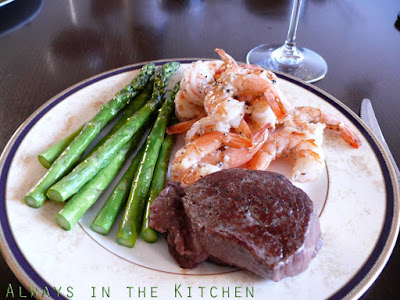 I love French food. I like the flavours, the unabashed use of butter and garlic, the reliance on duck and rabbit as part of the cuisine ordinaire. I like the traditions of wildcrafting, and of seasonal eating - abundance of whatever happens to be in season. I like the rustic stuff, and I like the highly refined, elegant stuff.
I love French food. I like the flavours, the unabashed use of butter and garlic, the reliance on duck and rabbit as part of the cuisine ordinaire. I like the traditions of wildcrafting, and of seasonal eating - abundance of whatever happens to be in season. I like the rustic stuff, and I like the highly refined, elegant stuff.There are plenty of simple French dishes, many of which (for example, a classic omelette) I make without stopping to think of them as French, per se. Then, of course, there are the dishes that simply use French accents - combining carrots and tarragon, or thyme with mushrooms.
I am also very, very lazy in my weekday cooking, and as such, I often look for ways to shortcut methods and still feel like I'm dining reasonably well. I'm also pretty big on variety, and cannot face pan-fried hamburgers in mushroom gravy three nights of the week on an ongoing basis (although, back in school, I suspected that I could).
Of late, we've been all about the skillet dinners. Assorted combinations of rice or pasta and some sort of meat (often chicken) and vegetables, and one-pan programming. You know, the sort of dinner that you can bang out quickly when you get home from work and you're kind of bagged, or you don't feel much like spending all night in the kitchen. There are, however, only so many variations of pasta and rice that can be made in a one-pot dinner, and I thought that I had run their course. Until, as it turned out, I was standing in the butcher shop staring at some lovely looking lean duck sausages, and a glimmering of an idea came about.
I've seen plenty of "easy cassoulet" recipes over the years, recipes which promise the rich, soul-satisfying taste of cassoulet in less time than the requisite two-day operation. I've seen one-day "cassoulet" and four-hour "cassoulet" but it seems a little disingenuous to claim them as the real deal. I suppose, what it comes down to, is that there are a lot of bean and sausage dishes, but not all of them are cassoulet.
I didn't have time to muck about with confit, and I didn't have any pork or fatty lamb handy, but I figured that, since the French themselves have such varied and vehement opinions as to what really qualifies as cassoulet, as long as I'm not claiming to make a particularly authentic dish, I can do what I want with the idea of it. Out of this perhaps somewhat arrogant reasoning, came dinner, in exactly 45 minutes from wandering into the kitchen and curling up on the sofa with a big old bowl in my lap.
I was somewhat shocked to realize that it is actually a fairly healthy dish, since the sausages that I used were not terribly fatty, and there was no added fat or oil in the dish. Quel surprise! I'll definitely be making this again.
French Skillet Dinner
aka "Not Cassoulet"
4 large duck sausages
1 large onion, diced
3 bay leaves
2 cloves of garlic, sliced
2 whole cloves (the spice)
pinch ground cloves
good pinch ground sage
pinch ground thyme, or sprig of fresh thyme
white pepper, to taste
2 - 3 cups cooked white beans, such as cannelini, white kidney, great northern, flageolet
2 medium carrots, diced
dry white vermouth
water
parsley
In a large, heavy, cast iron (or any not-non-stick) skillet, brown the sausages on all sides over high heat (no oil needed). Push the sausages to the side, and add the onions. Saute, stirring occasionally, until well caramelized, and add one of the cloves of garlic, and a good pinch of salt. Add the carrots, and saute and stir, adding a little vermouth from time to time if necessary to keep from burning.
The sausage should have developed a nice sticky brown fond on the bottom of the pan. Add about a half-cup of vermouth and scrape it up into the onion and carrot mixture. Add the bayleaves, whole cloves, ground cloves, white pepper, sage and thyme, all at once. Stir to distribute evenly. Add beans, and enough water to make a fairly loose stew. Simmer, uncovered, over a medium-low flame for about fifteen minutes, or until the gravy thickens and reduces.
Remove sausages and cut into chunks. Return sausage chunks to pan along with the second sliced clove of garlic. Stir well (but gently, so you don't mash all the beans). Taste the gravy and adjust for salt as needed. Drizzle an extra tablespoon of vermouth over the top, sprinkle generously with parsley, and serve with a nice glass of wine and a piece of crusty baguette.

















